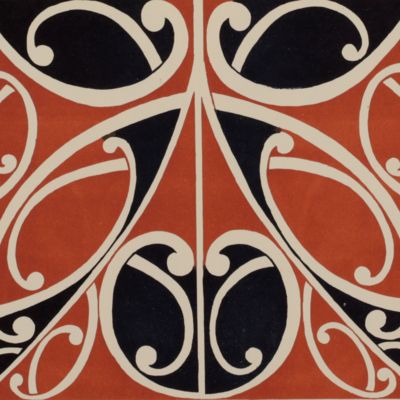Menzies, J. H.
Maori Patterns. Painted and Carved.
Christchurch, Smith and Antony, [1910]. Oblong folio (36.6 x 50.1 cm). Engraved title page in red and black; explanatory leaf; 28 plates. Original white linen boards with colour-printed title mounted. Preserved in protective clamshell box of blue half morocco over blue linen boards; "spine" with wavy giltlines and gilt title. Marbled inside.
Rare only edition of an interesting pattern book of Māori decoration and ornament, featuring carvings and rafter patterns (kowhaiwhai), as well as Māori texts, the latter translated by Hare Hongi on a separate, printed page. The author, John Henry Menzies (1839-1919) was born in Liverpool of Scottish descent. He arrived in New Zealand in1860, and settled first in Southland, where he bought, developed and sold land. In 1878, he moved to McIntosh Bay on Banks Peninsula (Horomaka), near Christchurch. He bought the land from Tom McIntosh, and in 1879 built the homestead "Glen Mona". in the place of McIntosh’s simple cottage. The new homestead was elaborately decorated with carvings of Māori patterns and flower motifs. The bay was renamed to Menzies Bay. Menzies put his usual energy into developing the property (about 4,400 acres). He studied Māori patterns and felt that he had gained an inkling of what they stood for (J. Hector, on astro-uni website). The introduction by Menzies consists of a short history of Māori carving. "I have attempted to collect and perpetuate these beautiful patterns, painted and carved... carved most of them in wood and stone myself, and have been more and more struck by the good taste and art shown in them. They belong only to New Zealand, are not found in the other islands inhabited by a people calling themselves Māori in the Pacific" (Menzies). We found only one auction record. OCLC records fewer than ten copies, including four in the USA, viz., Bernice P. Bishop Museum Library, Connecticut College, Indiana University, and Northwestern University. Bookplate of the publisher mounted on front and rear pastedown. Boards a bit soiled; edges with light shelf-wear; front free endpaper a bit spotted, otherwise very good.




